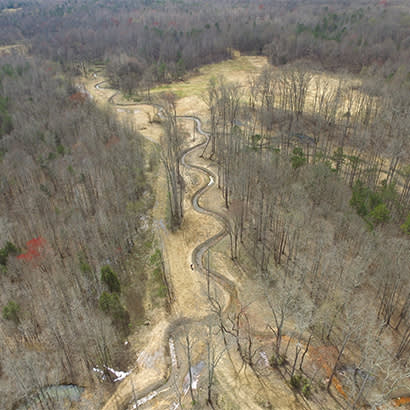
For an enhanced digital experience, read this story in the ezine.
Nearly 10 years ago, Charlotte-Mecklenburg Storm Water Services reached out to Mecklenburg County Park and Recreation to ask if the department was interested in partnering on one of the largest urban stream restoration projects in the state of North Carolina. Reedy Creek was heavily impacted by past farming practices and stormwater runoff from nearby development and no longer supported healthy communities of native fishes and aquatic insects. The goal was to preserve, enhance and restore more than 40,000 feet (7.5 miles) of the stream and to use a science-based approach to document the recovery of the creek.
The project would take place in the 1,000-acre Reedy Creek Park and Nature Preserve, one of 27 nature preserve properties included in the Mecklenburg County park system. The park and nature preserve prioritizes the conservation and protection of natural resources, rare species and unusual habitats while promoting passive recreation opportunities. Despite the demonstrated need to restore the stream, there were concerns about performing this massive construction project within the nature preserve. It would result in the removal of many large trees, displacement of woodland bird species, impact on amphibians and reptiles, and the closure of the heavily used nature trail system for almost two years.
To proactively address these concerns, the project team directed considerable resources toward public outreach and education to help the general public, park staff, elected officials and others understand why the project was needed, what to expect during construction and what the stream would look like once it was restored. Initial meetings with a citizen advisory board to the Mecklenburg County Park and Recreation Commission, known as the Stewardship Advisory Council, focused on building support for the project. Next, the Park and Recreation Commission heard presentations from city staff, park staff and the consulting team and approved the project. The focus then shifted to educating the general public about the project. A newspaper article was published, the city attended the park’s Hummingbird Festival, the team mailed a postcard to residents, and signage explaining the project goals and duration were posted at trail heads more than a year in advance of construction. Another round of outreach to all audiences occurred before construction started, and Storm Water Services even did an interview with local news. Wildlands Engineering Inc., the design consultant, created an interactive project website to provide maps, pictures, updates and answers to frequently asked questions, as well as a link to the Mecklenburg County Park and Recreation website. As a result, the project was completed with almost no negative press or public concern. In fact, many park patrons are amazed by how great the stream looks and how quickly the vegetation has started to recover.
As part of post-construction monitoring, the nature center at Reedy Creek installed phone frame stations so park visitors can help document the recovery of the restored stream via a social media-based citizen science project. Engaging the public in a way that allows them to share their observations of new grasses, growing trees, and bird and wildlife sightings creates a connection to Reedy Creek and nature. We can’t think of a better way to connect our community to our natural resources and local parks.
Erin Shanaberger, PWS, is Watershed Planning and Project Implementation Supervisor for the city of Charlotte.

